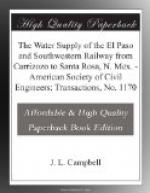The bands were bent in the field, and, after heating in an oven for about 3 min., were dipped in bunches of five into a kettle of melted mineral rubber at a temperature of about 400 deg. Fahr., and then hung up for the coating to harden. This took place rapidly, as the work was done in winter. If the band were wound spirally, the coating would have to be done in the shop, but field coating is preferable, as it avoids injury to the coating during transportation.
An advantage of wood pipe for conveying water is its low coefficient of friction. The results obtained by the author (n = 0.00866 to 0.0092) appear to be very low as compared with determinations made for wood-stave pipe. Kutter’s coefficient for the latter varies from 0.0096 in the case of the 30-in. pipe at Denver,[B] to from 0.012 to 0.015 as determined by Messrs. Marx, Wing, and Hoskins for the 72-in. pipe of the Pioneer Power Plant of Ogden.[C] Probably 0.011 would be a fairly safe figure to use in designing new work.
[Illustration: FIG. 3. DETAILS OF OLD WOOD PIPE.]
J.L. CAMPBELL, M. AM. SOC. C.E. (by letter).—Referring to Mr. Smith’s question about the velocity measurements by bran, the first appearance of the bran and the colors was taken because the intervals of time given thereby were in close accord among themselves and with the weir measurements. The time from the first trace of bran or color until final disappearance varied between 15 and 20 min. Bran in abundance or pronounced color showed in 2 min. after the first appearance, while the disappearance or fading was noticeable after a period of from 7 to 10 min. It required 2-1/2 min. to get the bran or colors into the intake at the head of the line and leave the water clear.
[Footnote B: Transactions, Am. Soc. C.E., Vol. XXXVI, p. 26.]
[Footnote C: Journal, New England Water Works Assoc., Vol. XXII, p. 279.]
Mr. Allen refers to the bored wood pipe laid many years ago in Eastern cities. The writer’s experience indicates that a bored pipe will not deliver as much water as a planed stave pipe, on account of the greater interior roughness of the former.
Referring to the profile, the 8-1/2-in. pipe between Corona and Duran had a theoretical capacity of 744,000 gal. per day. A recent test showed it to be delivering water at the rate of 759,000 gal. per day.
The 3-1/2-in. pipe between Vaughn and Pastura had a theoretical capacity of 84 000 gal. per day. It delivers only 65,000 gal. per day. There are 5 miles of bored pipe on the upper end of this section. Pressure gaugings show a hydraulic gradient in excess of the theoretical on the bored pipe, whereas the stave pipe on the lower end carries the 65,000 gal. on a flatter gradient than the theoretical one.
Experience on this pipe line indicates that n = 0.009, in Kutter’s formula, closely approximates the capacity of planed wood stave pipes of 8 to 16 in. in diameter. The writer favors the use of 0.01 as conservative and economical.




